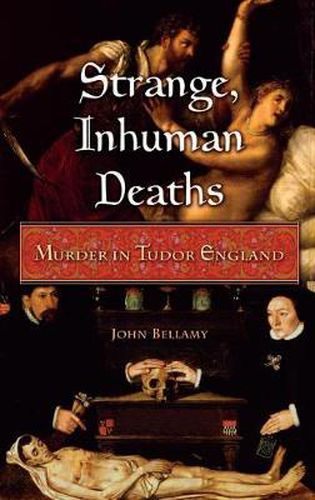Readings Newsletter
Become a Readings Member to make your shopping experience even easier.
Sign in or sign up for free!
You’re not far away from qualifying for FREE standard shipping within Australia
You’ve qualified for FREE standard shipping within Australia
The cart is loading…






In 1573 there occurred a murder which would leave today’s tabloid editors salivating. George Saunders, a respected merchant tailor, was killed by his wife’s lover. Involved in the conspiracy were Saunders’ wife, her best friend, and a servant. All were found guilty and hanged, but not before a suspended clergyman fell in love with Mrs. Saunders and sought to have her pardoned. Murder was relatively rare in Tudor times. When it did occur, especially if it involved a female perpetrator and a love affair, it generated widespread interest. The rise of Protestantism, and its accompanying rise in literacy, had provided a strong impetus to read about crime and to ponder the spiritual consequences of breaking both the civil and the divine law. The English system of criminal justice was open and popular, and familiar elements-detection, investigation, the laying of charges, the trial, verdict, sentence-were all well understood and closely followed in the 16th century. Today, people are riveted by crime and violence. But the obsession is not new, as this book shows in vivid and exciting detail.
John Bellamy’s new book provides a fascinating view of life in Tudor England and offers a new angle on our love affair with murder as a literary form. It was in the Tudor period, he argues, that popular attention was focused on the crime of murder, for edification as well as entertainment. A 16th-century murder inquiry was in many ways a community affair, capable of arousing the interest of a substantial local audience, with the members of the inquest often collecting evidence and statements for twenty or thirty days. Detection, investigation, the laying of charges, the trial, verdict, sentence-all of these familiar elements were established in the 16th century. Strange, Inhuman Deaths describes four well-documented cases that occurred between 1538 and 1573. Each of them is deeply rooted in source material, whether legal records or pamphlets, plays or ballads, giving a rich background and a wealth of local colour. The human stories they contain are powerful and lively, and the motivations and personalities that are revealed speak to us directly across the centuries. Murder most foul, murder most English-the tradition begins.
$9.00 standard shipping within Australia
FREE standard shipping within Australia for orders over $100.00
Express & International shipping calculated at checkout
In 1573 there occurred a murder which would leave today’s tabloid editors salivating. George Saunders, a respected merchant tailor, was killed by his wife’s lover. Involved in the conspiracy were Saunders’ wife, her best friend, and a servant. All were found guilty and hanged, but not before a suspended clergyman fell in love with Mrs. Saunders and sought to have her pardoned. Murder was relatively rare in Tudor times. When it did occur, especially if it involved a female perpetrator and a love affair, it generated widespread interest. The rise of Protestantism, and its accompanying rise in literacy, had provided a strong impetus to read about crime and to ponder the spiritual consequences of breaking both the civil and the divine law. The English system of criminal justice was open and popular, and familiar elements-detection, investigation, the laying of charges, the trial, verdict, sentence-were all well understood and closely followed in the 16th century. Today, people are riveted by crime and violence. But the obsession is not new, as this book shows in vivid and exciting detail.
John Bellamy’s new book provides a fascinating view of life in Tudor England and offers a new angle on our love affair with murder as a literary form. It was in the Tudor period, he argues, that popular attention was focused on the crime of murder, for edification as well as entertainment. A 16th-century murder inquiry was in many ways a community affair, capable of arousing the interest of a substantial local audience, with the members of the inquest often collecting evidence and statements for twenty or thirty days. Detection, investigation, the laying of charges, the trial, verdict, sentence-all of these familiar elements were established in the 16th century. Strange, Inhuman Deaths describes four well-documented cases that occurred between 1538 and 1573. Each of them is deeply rooted in source material, whether legal records or pamphlets, plays or ballads, giving a rich background and a wealth of local colour. The human stories they contain are powerful and lively, and the motivations and personalities that are revealed speak to us directly across the centuries. Murder most foul, murder most English-the tradition begins.